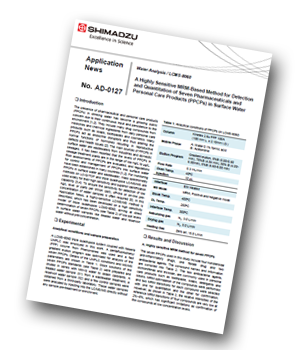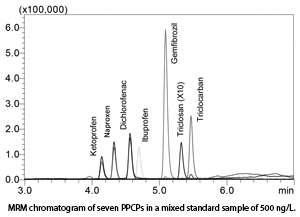Shimadzu has produced an application note describing a high sensitivity detection method for the detection of Pharmaceuticals and Personal Care Products (PPCPs) in surface water that does not require pre-treatment and concentration of water samples.

 Pharmaceuticals and Personal Care Products (PPCPs) are a class of environmental contaminants that have raised public health and ecological concerns. PPCPs are often found in daily care products such as body lotions and cosmetics, which are often used and washed off into domestic sewages. Current waste water treatment plants may not be effective or efficient in removing these compounds. Therefore, constant surveillance and detection of PPCPs in water bodies is required to address these concerns. To enable trace level detection, PPCPs detection in water bodies is often a laborious procedure involving pre-treatment and concentration of a large number of samples. Methods that can streamline the operation workflow and improve efficiency are often favoured.
Pharmaceuticals and Personal Care Products (PPCPs) are a class of environmental contaminants that have raised public health and ecological concerns. PPCPs are often found in daily care products such as body lotions and cosmetics, which are often used and washed off into domestic sewages. Current waste water treatment plants may not be effective or efficient in removing these compounds. Therefore, constant surveillance and detection of PPCPs in water bodies is required to address these concerns. To enable trace level detection, PPCPs detection in water bodies is often a laborious procedure involving pre-treatment and concentration of a large number of samples. Methods that can streamline the operation workflow and improve efficiency are often favoured.
 To improve operational efficiency, we present a high sensitivity detection method which does not require pre-treatment and concentration of water samples. The method uses a model of triple quadrupole LCMS-8060 system coupled with the Nexera UHPLC; enabling a fast gradient elution program with a pentafluorophenyl (PFP) column. The method was optimized using seven PPCPs and demonstrated good repeatability with a %RSD in a range of 1.7% ~7.2%. With high sensitivity, the limit of detection achieved using this method ranged from 1.0 ng/L to 13.5 ng/L.
To improve operational efficiency, we present a high sensitivity detection method which does not require pre-treatment and concentration of water samples. The method uses a model of triple quadrupole LCMS-8060 system coupled with the Nexera UHPLC; enabling a fast gradient elution program with a pentafluorophenyl (PFP) column. The method was optimized using seven PPCPs and demonstrated good repeatability with a %RSD in a range of 1.7% ~7.2%. With high sensitivity, the limit of detection achieved using this method ranged from 1.0 ng/L to 13.5 ng/L.




